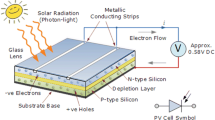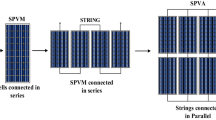Abstract
In order to improve the quality of polysilicon solar power generation system, the output power variation of polysilicon solar power generation system with temperature factor is analyzed in the present paper. The functions of photoelectric current, series resistance, parallel resistance, and temperature are obtained through the current and voltage display equations of solar cells, and the mathematical model of photovoltaic connection circuit in the series/parallel solar power generation system is established. The quadratic interpolation method is used to track the maximum output power of the series/parallel solar power generation system. The influence of temperature on the key parameters such as the maximum output power, the maximum photoelectric efficiency mode output power, and the constant voltage mode output power of the PV/T system composed of polysilicon photovoltaic cells is analyzed. The results show that when the temperature is different, the series circuit decreases by 58.08, 58.12, and 50.51%. The maximum output power, maximum photoelectric efficiency mode output power, and constant voltage mode output power of the polysilicon solar power generation system decreased by 2.05, 2.05, and 4.76%, respectively, with the increase of local temperature, and the parallel circuit decreased by 5.31, 8.73, and 50.51%, respectively, in order to improve the power generation quality of the polysilicon solar power generation system.








Similar content being viewed by others
References
Anand A, Veciana GD (2018) Resource Allocation and HARQ Optimization for URLLC Traffic in 5G Wireless Networks. J Areas Commun 36(11):2411–2421
Bai QQ, Zhang Q, Rao YZ (2018) Informatization contributes to modernize the trial power operation system. J Chin Acad Electron Inf Technol 13:227–230
Chow C, Shiu R, Liu YC, Liu Y, Yeh CH (2018) Non-flickering 100 m RGB visible light communication transmission based on a CMOS image sensor. Opt. Express 26(6):70–79
Dai J, Xiao WB, Hu FY, Wu SY (2018) Research of photovoltaic prediction model. Chin J Information Sour 2:262–266
Fan ZC, Feng HW, Chen J (2017) Study on annealing behavior of polycrystalline silicon for solar panels. Foundry Technol 38:1328–1331
Gaeini M, Rouws AL, Salari JWO, Zondag HA, Rindt C (2018) Characterization of microencapsulated and impregnated porous host materials based on calcium chloride for thermochemical energy storage. Appl Energy 212(15):1165–1177
Hong Y (2017) Structural characteristics and applications of Hilbert’s type integral inequalities with homogenous kernel. J Jilin U (Sci Ed) 55:189–194
Li PY, Wang K, Jiang DC, Ren SQ (2017a) Coupling of metallurgical method to remove impurities in solar grade polycrystalline silicon. J Inorg Mater 32:281–286
Li YQ, Zhang LF, Ma YS, Muslim RR (2017b) Recent developments in metallurgical grade silicon purification by solidification refining and slag refining process. J Funct Mater 48:28–34
Li YB, Zhang ST, He YF, Liang SM, Han JD, Fu H, Zhao LL (2019) Three dimensional numerical simulation of electronic grade polysilicon reduction furnace based on polysim software. J Synth Cryst 48:144–148
Liu ZH, Luo YF, Rao SL, Hu Y, Zhang FY, Gong HY, Liu J (2018) Study on directional solidification of polycrystalline silicon under axial magnetic field. Hot W Technol 47(88-91):95
Lv HZ, Liu YC, Li PL, Zhang ZX (2018) Study on the optimal flow of electric power system with wind electric field based on power generation benefit and environmental cost. Automat & Instr 5:43–47
Saitoh K, Oyama N, Ogushi F, Luding S (2019) Correction: Transition rates for slip-avalanches in soft athermal disks under quasi-static simple shear deformations. Soft Matter 15:3627
Wang SY, Wang Z, Fu CQ, Luo XL, Zhang YL (2017) The influence of phosphorus content on piezoresistive properties of polycrystalline silicon thin film synthesized by pulsed laser deposition. Mater Rev 31(150-152):156
Yang XB, Liu K (2017) Progress on perovskite solar cells. J Mater Sci Eng 1:142–150
Yu ZQ, Ma WH, Wei KX, Lv GQ, Chen ZJ (2018) Analysis of energy payback time and carbon footprint of metallurgical route polysilicon PV power system. Acta Energi Sin 2:520–528
Zhang T, Guo YG, Qu XY, Chen L, Wang JL (2017) Research on surface texture of multicrystalline silicon by reactive ion etching. J Synth Cryst 46:2090–2094
Zhao MZ, He JP, Zheng B (2017) Model and prediction of CM conducted emission cumulative effects in parallel-inverter generation system. J Pow Supply 15:9–17
Acknowledgment
The research is supported by the Fundamental Research Funds for the Central Universities (No. 2017MS121).
Author information
Authors and Affiliations
Corresponding author
Additional information
This article is part of the Topical Collection on Geological Modeling and Geospatial Data Analysis
Rights and permissions
About this article
Cite this article
Li, W., Wang, J. & Weng, Y. Analysis of output power change of polycrystalline silicon solar power generation system considering temperature factor. Arab J Geosci 13, 907 (2020). https://doi.org/10.1007/s12517-020-05886-7
Received:
Accepted:
Published:
DOI: https://doi.org/10.1007/s12517-020-05886-7




